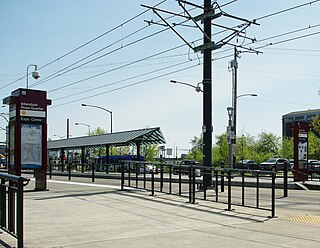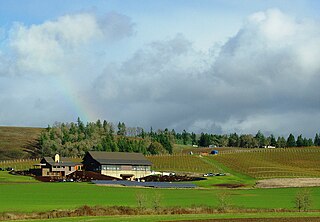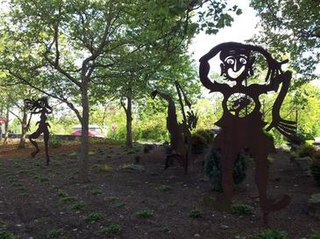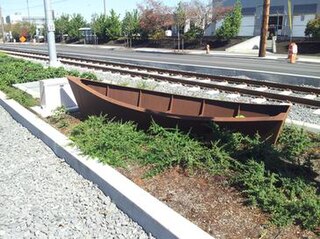
Interstate/Rose Quarter station is a light rail station on the MAX Yellow Line in Portland, Oregon. It is the first stop northbound on the Interstate MAX extension. About 200 yards away is the Rose Quarter Transit Center's MAX station, where transfers to the eastbound MAX Blue and Red lines and the southbound Green Line are possible. Several bus lines also serve the transit center, making stops in the area between the two MAX stations.

The Lloyd District is a primarily commercial neighborhood in the North and Northeast sections of Portland, Oregon. It is named after Ralph Lloyd (1875–1953), a California rancher, oilman, and real estate developer who moved to and started the development of the area.

Oregon Pioneer, also known as Gold Man, is an eight-and-a-half ton bronze sculpture with gold leaf finish that sits atop the Oregon State Capitol in Salem, Oregon, United States. Created by Ulric Ellerhusen, the statue is a 22 ft (7 m)-tall hollow sculpture. The gilded piece was installed atop the building in 1938 when a new capitol was built.

Solar power in Oregon has been growing in recent years due to new technological improvements and a variety of regulatory actions and financial incentives enacted by the state government.

Kvinneakt is an abstract bronze sculpture located on the Transit Mall of downtown Portland, Oregon. Designed and created by Norman J. Taylor between 1973 and 1975, the work was funded by TriMet and the United States Department of Transportation and was installed on the Transit Mall in 1977. The following year Kvinneakt appeared in the "Expose Yourself to Art" poster which featured future Mayor of Portland Bud Clark flashing the sculpture. It remained in place until November 2006 when it was removed temporarily during renovation of the Transit Mall and the installation of the MAX Light Rail on the mall.

Pod is the name of a 2002 modern sculpture by American artist Pete Beeman, currently installed at Southwest 10th Avenue and West Burnside Street in downtown Portland, Oregon. The 30-foot (9.1 m) sculpture, intended to represent the "infrastructure, energy, and vibrancy of Portland," is supported by its static tripod base with a 15-foot (4.6 m) diameter. It is constructed from stainless steel, galvanized steel, bronze, titanium, lead and other materials. Pod was fabricated by Beeman and David Bermudez, and engineered by Beeman and Peterson Structural Engineers. It is considered interactive and kinetic, with a central, vertical pendulum that swings back and forth when pushed. The sculpture cost as much as $50,000 and was funded by the Portland Streetcar Project. Pod is part of the City of Portland and Multnomah County Public Art Collection courtesy of the Regional Arts & Culture Council.

Nepenthes is a series of four sculptures by artist Dan Corson, installed in 2013 along Northwest Davis Street in the Old Town Chinatown neighborhood of Portland, Oregon, in the United States. The work was inspired by the genus of carnivorous plants of the same name, known as tropical pitcher plants. The sculptures are 17 feet (5.2 m) tall and glow in the dark due to photovoltaics.

People's Bike Library of Portland, also known as Zoobomb Pyle or simply "the pile", is a 2009 steel and gold leaf sculpture by local artists Brian Borrello and Vanessa Renwick, located in Portland, Oregon, in the United States. It was erected in collaboration with the Zoobomb bicycling collective, and serves as a bicycle parking rack, a "lending library" for weekly bike riders, and a monument to the city's bike culture. The sculpture features a two-story spiral pillar with a gold-plated small bicycle on top; bicycles intended for Zoobomb riders are locked to the pillar and base, which has metal loops serving as hooks.

Little Prince, also known as The Little Prince, is an outdoor 1995 copper and steel sculpture created by artist Ilan Averbuch, located in the Rose Quarter of Portland, Oregon. It is part of the City of Portland and Multnomah County Public Art Collection, courtesy of the Regional Arts & Culture Council.

Terra Incognita is an outdoor 1995 sculpture by Israeli artist Ilan Averbuch, located at the foot of the Broadway Bridge in Portland, Oregon.

Three Figures is an outdoor sculpture by American artist Mark Bulwinkle, located at Northeast 13th Avenue and Northeast Holladay Street in Portland, Oregon's Lloyd District. The installation includes three bronze or steel figures, created during 1991–1992, each measuring between 8 feet (2.4 m) and 10 feet (3.0 m) tall. Originally installed at AVIA's corporate headquarters, the figures were donated to the City of Portland and relocated to their current location "to appear to be enjoying the green space". Three Figures is part of the City of Portland and Multnomah County Public Art Collection courtesy of the Regional Arts & Culture Council.

The Frank E. Beach Memorial Fountain, officially titled Water Sculpture, is an abstract 1975 stainless steel fountain and sculpture by artist Lee Kelly and architect James Howell, installed in Washington Park's International Rose Test Garden in Portland, Oregon. The memorial commemorates Frank E. Beach, who christened Portland the "City of Roses" and proposed the Rose Festival. It was commissioned by the Beach family and cost approximately $15,000. Previously administered by the Metropolitan Arts Commission, the work is now part of the City of Portland and Multnomah County Public Art Collection courtesy of the Regional Arts & Culture Council.

Host Analog is an outdoor 1991 sculpture by Buster Simpson located outside the Oregon Convention Center in Portland, Oregon, United States.

Festival Lanterns is an outdoor 2006 art installation consisting of granite and steel sculptures by American artist Brian Goldbloom, installed in northwest Portland, Oregon, in the United States. The work is administered by the Regional Arts & Culture Council.

Passage is an outdoor 2014 art installation consisting of 38 weathered steel boat sculptures by Bill Will, installed along the MAX Orange Line in the Brooklyn neighborhood of southeast Portland, Oregon, in the United States.

Trio is an outdoor 2013 art installation by Seattle artist Elizabeth Conner, installed at the MAX Orange Line's Lincoln Street/Southwest 3rd Avenue MAX Station in Portland, Oregon, United States.

To Grandmother's House is an outdoor wooden sculpture by Patrick Gracewood, installed near the Southeast Park Avenue station in Oak Grove, an unincorporated area neighboring Milwaukie in Clackamas County, Oregon, in the United States. It depicts an older woman holding a rabbit in her arms and was carved from a 75-year-old cedar tree, cut down for construction of the MAX Orange Line, over three years. The sculpture was installed on April 29, 2015.

Along These Lines is an outdoor 2015 stainless steel sculpture and paving medallion by Anne Storrs, installed at the Rhine–Lafayette Pedestrian Overpass landings at the MAX Orange Line's Southeast 17th Avenue and Rhine Street station in southeast Portland, Oregon's Brooklyn neighborhood, in the United States.
Velosaurus is an outdoor 2015 concrete and painted steel sculpture by Horatio Law, installed beneath the Powell Blvd. Light Rail Overpass between the MAX Orange Line's Clinton St/SE 12th Ave and Clinton St/SE 12th Ave stations in southeast Portland, Oregon, in the United States. The piece is a series of eight bas-relief panels made of recycled bicycle and skateboard parts, arranged to appear like dinosaur skeletal remains.
Brian Borrello is an American artist. He is based in Portland, Oregon, United States.

















